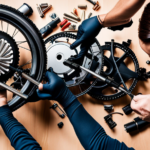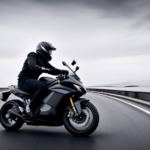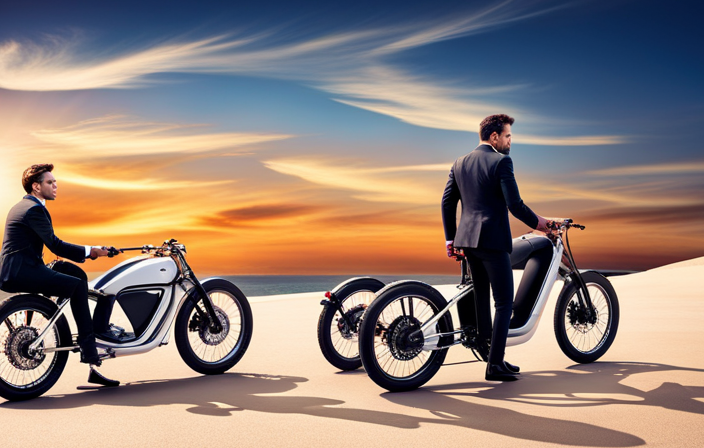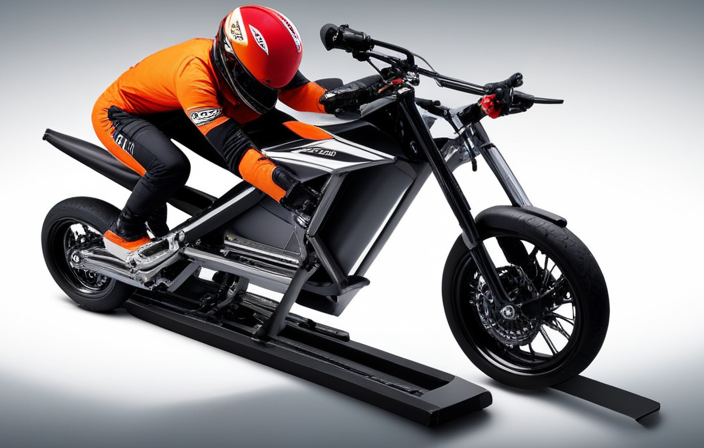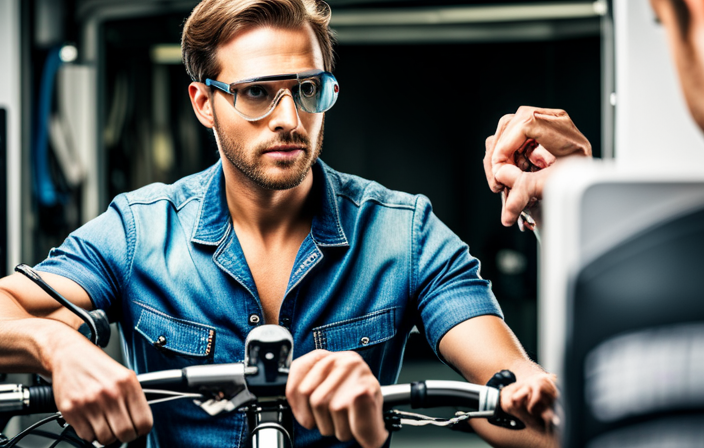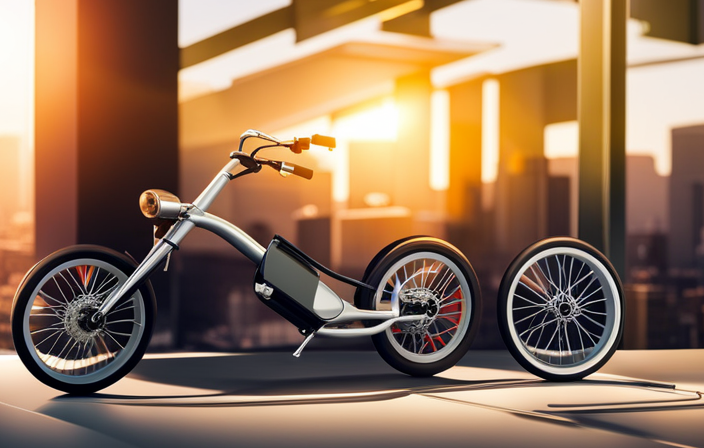Do you find yourself pedaling without moving on your e-bike? Don’t let frustration take over! Your bike might just need a little troubleshooting to get back on the road.
In this article, we will explore the possible reasons why your electric bike won’t work and guide you through a step-by-step process to diagnose and fix the issue.
So, tighten your helmet and let’s dive into the world of electric bike problem-solving!
Key Takeaways
- Unexplained loss of power can indicate a fault in the motor or battery system, and it is important to consult a professional technician for accurate diagnosis and fixing.
- Strange noises or vibrations are often indicators of mechanical problems, and professional technicians can identify the source of the issue and perform necessary repairs.
- Electrical malfunctions, such as lights or display not working, should be addressed by professionals who have expertise in troubleshooting and repairing wiring or connection issues.
- Complex repairs should be left to professional technicians as failed DIY attempts may require their guidance, knowledge, and tools to effectively tackle the issues.
Check the Battery Connection
Check if the battery isn’t properly connected.
To troubleshoot the battery connection, begin by inspecting the battery wiring. Make sure that all the wires are securely attached and that there are no loose connections. Take a close look at the connectors and terminals to ensure they are clean and free from corrosion. If you notice any damage or frayed wires, they may need to be replaced.
Additionally, check if the battery is securely mounted in its designated place. A loose battery can cause disconnection issues.
Once you have confirmed that the battery connection is secure, you can move on to the next step of troubleshooting, which is ensuring that the battery is charged and functioning correctly.
Ensure the Battery is Charged
Make sure the battery’s charged. Troubleshooting battery issues is crucial when your electric bike won’t work. The first step is to ensure that the battery is fully charged.
Inspect the charging cable and make sure it is securely connected to both the battery and the power source. Look for any signs of damage or wear on the cable. Check if the charger light is on when plugged in. If not, it could indicate a faulty charger. You can also test the charger by using it on a different device to see if it functions properly. If the charger is indeed faulty, you may need to replace it.
Once you have confirmed that the battery is charged, it is time to move on to examining the motor and wiring to further diagnose the issue.
Examine the Motor and Wiring
Take a close look at the motor and wiring to troubleshoot motor issues and identify any wiring problems.
Start by examining the motor itself. Look for any visible signs of damage, such as loose or disconnected wires, burnt or frayed insulation, or broken components. Check the motor’s connections to ensure they are secure and tightly fastened.
Next, inspect the wiring that connects the motor to the battery and controller. Look for any loose or damaged wires, as well as any signs of corrosion or rust. If you find any issues, repair or replace the affected parts as necessary.
Once you have examined the motor and wiring, you can move on to testing the throttle and controller to further diagnose the problem.
Test the Throttle and Controller
To troubleshoot the issue with your electric bike, start by testing the throttle and controller. The throttle is responsible for controlling the speed of the bike, while the controller manages the power flow from the battery to the motor. Begin by checking the throttle connection to ensure it is securely plugged in. If the connection is loose, reattach it firmly. Next, test the throttle by twisting it and observing the response. If there is no response or the bike doesn’t accelerate, the throttle may be faulty and require replacement. Moving on to the controller, familiarize yourself with its functions by referring to the user manual. Check if the controller is powered on and if all the wires are properly connected. If everything appears to be in order but the bike still doesn’t work, it may be necessary to inspect the brake system for any potential issues.
Inspect the Brake System
Inspecting the brake system is crucial to ensure the safe operation of your e-bike. To check the brake pads, follow these steps:
-
Look for any signs of wear or thinning on the brake pads. If they are less than 3mm thick, they need to be replaced.
-
Check the alignment of the brake pads with the rim. They should be centered and not rubbing against the tire.
-
Examine the brake cables for any fraying, kinks, or signs of damage. Replace them if necessary.
-
Test the brake lever to ensure it engages smoothly and quickly stops the bike.
By thoroughly inspecting the brake system, you can identify any issues that may be causing your electric bike to not work properly.
Once you have checked the brake pads and inspected the brake cables, it’s important to look for any loose or damaged parts to address in the subsequent section.
Look for Any Loose or Damaged Parts
Now that you have inspected the brake system, it is time to move on to the next step in troubleshooting your electric bike.
The current subtopic is to look for any loose or damaged parts. This is an important step because common issues with electric bikes often stem from loose or damaged components.
Begin by carefully examining the entire bike, paying close attention to the frame, handlebars, pedals, and any other areas where parts may be attached. Look for any signs of wear and tear, such as cracks, rust, or loose screws.
Tighten any loose parts using the appropriate tools and replace any damaged components as necessary. By thoroughly inspecting and addressing any loose or damaged parts, you can ensure that your electric bike is in optimal working condition.
Moving forward, let’s verify the tire pressure in the next section.
Verify the Tire Pressure
Check the tire pressure on your electric bike to ensure optimal performance. Proper tire pressure is crucial for the smooth operation of your electric bike and can affect its speed, handling, and overall efficiency. To troubleshoot the motor and maximize your riding experience, follow these steps:
- Use a digital tire pressure gauge to measure the pressure in each tire accurately.
- Refer to your electric bike’s manual or the manufacturer’s recommendations for the ideal tire pressure.
- Adjust the pressure using a bike pump, adding or releasing air as necessary.
- Double-check the tire pressure after making adjustments to ensure it meets the specified range.
By checking the tire pressure regularly, you can prevent potential issues such as decreased battery life, increased rolling resistance, and unstable riding conditions.
Once you have verified the tire pressure, it’s time to move on to the next section and address the importance of cleaning and lubricating the chain.
Clean and Lubricate the Chain
To ensure optimal performance, make sure you clean and lubricate the chain on your electric bike regularly. Cleaning and lubricating the chain is essential for optimal performance and the longevity of your electric bike.
Over time, dirt, dust, and debris can accumulate on the chain, which can lead to increased friction and wear. By regularly cleaning the chain, you can remove these particles and prevent them from causing damage. Additionally, lubricating the chain helps to reduce friction and improve the overall efficiency of the bike. This not only enhances the performance of your electric bike but also prolongs its lifespan.
Once you have cleaned and lubricated the chain, the next step is to adjust the electric bike’s settings for a smooth and enjoyable ride.
Adjust the Electric Bike’s Settings
Make sure to adjust your electric bike’s settings for a smooth and enjoyable ride.
When troubleshooting issues with your electric bike, one of the first steps you should take is to adjust the power settings. This can help address problems such as poor acceleration or difficulty in climbing hills.
Start by checking the power level on your bike’s display and ensure that it is set to an appropriate level for your desired riding experience. Additionally, you may need to adjust the pedal assist level or throttle sensitivity to optimize your bike’s performance.
Experiment with different settings to find the right balance between power and efficiency.
If, after adjusting the settings, your electric bike still doesn’t work properly, it may be time to consult a professional technician for further assistance.
Consult a Professional Technician if Necessary
If you’re experiencing persistent issues with your electric bike, it might be worth seeking the help of a professional technician. While adjusting the settings can often resolve minor problems, there are certain situations that require the expertise of a trained technician.
Here are four indications that it’s time to consult a professional:
-
Unexplained loss of power: If your electric bike suddenly loses power without any apparent reason, it could be due to a fault in the motor or battery system. A technician will be able to diagnose and fix the issue accurately.
-
Strange noises or vibrations: Unusual sounds or vibrations during operation can indicate mechanical problems. A technician can identify the source of the issue and perform the necessary repairs.
-
Electrical malfunctions: If the electrical components of your electric bike are not functioning correctly, such as the lights or display, a professional technician can troubleshoot and repair the wiring or connections.
-
Complex repairs: If you’ve attempted to fix the problem yourself but haven’t had any success, it’s time to seek professional guidance. A technician will have the knowledge and tools to tackle complex repairs effectively.
Remember, consulting a professional technician is essential to ensure the safe and efficient operation of your electric bike.
Frequently Asked Questions
How do I clean and lubricate the chain on my electric bike?
To clean and lubricate the chain on your electric bike, start by using a degreaser and a brush to remove dirt and grime. Rinse with water and dry thoroughly. Apply a bicycle-specific lubricant evenly along the chain, wiping off any excess. Repeat regularly for optimal chain maintenance.
How do I adjust the settings on my electric bike?
To adjust the settings on your electric bike, start by accessing the control panel. From there, you can adjust the pedal assist level to your desired setting. If you’re experiencing battery issues, troubleshoot by checking the connection and charge level.
What should I do if I notice any loose or damaged parts on my electric bike?
If you notice any loose or damaged parts on your electric bike, you should take immediate action. To fix a punctured tire, locate the hole, remove the tire, patch the hole, and reassemble. To replace brake pads, remove the old pads, install new ones, and adjust the brake system.
How do I test the throttle and controller on my electric bike?
To test the throttle and controller on your electric bike, start by testing the battery voltage. Then, troubleshoot the motor by checking the connections, controller settings, and motor resistance. Remember the adage: "Measure twice, cut once."
When should I consult a professional technician for help with my electric bike?
To ensure the best performance of your electric bike, seek professional help when you encounter complex issues beyond basic troubleshooting. They can diagnose and fix common problems like faulty controllers, malfunctioning batteries, or motor issues.
Conclusion
In conclusion, if you find yourself asking why your electric bike won’t work, it’s crucial to go through a thorough troubleshooting process.
Check the battery connection, ensure it’s charged, and examine the motor and wiring.
Test the throttle and controller, inspect the brake system, and verify the tire pressure.
Additionally, clean and lubricate the chain, and adjust the bike’s settings.
If all else fails, don’t hesitate to consult a professional technician for further assistance.
Remember, taking these precise and detailed steps will help you get back on your electric bike with confidence and efficiency.





